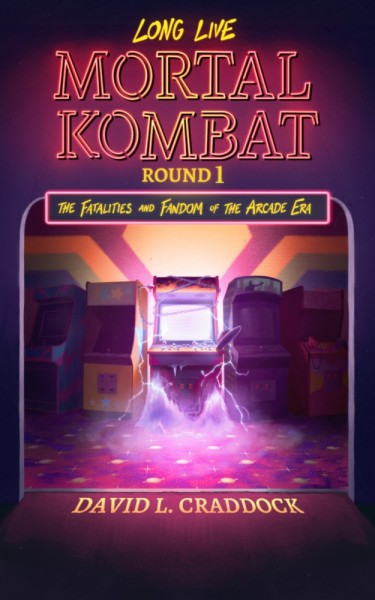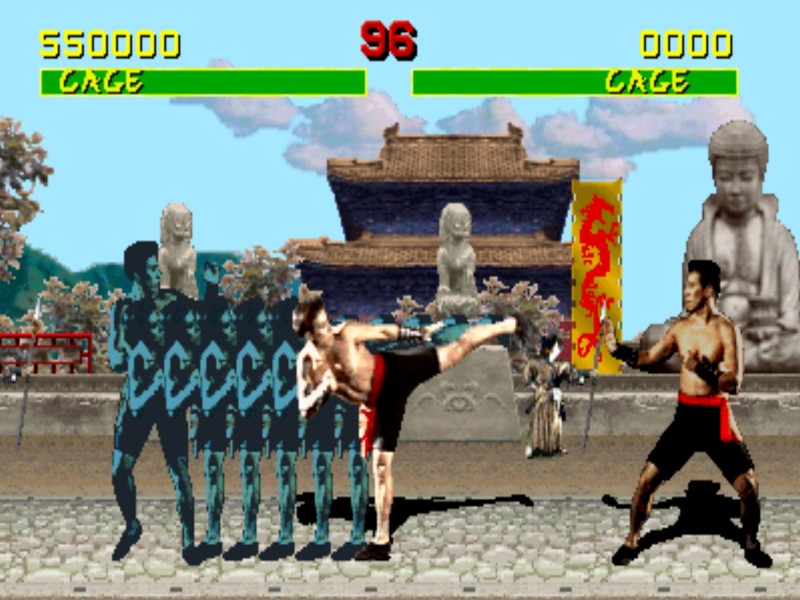Read An Exclusive Excerpt From Long Live Mortal Kombat: Round 1, A Novel On The Early History Of MK

Long Live Mortal Kombat: Round 1 – The Fatalities and Fandom of the Arcade EraAn upcoming novel will tell the story of Mortal Kombat’s origins and history. This book includes interviews with John Tobias, co-creator of MK, as well as other designers, critics and fans, to provide a detailed account about the franchise’s beginnings. Author David L. Craddock (Keep listening and staying a while trilogy, Monsters in Darkness: UFO Defense: How X-COM came to be) has launched a Kickstarter campaign to get the book off the ground and shared an exclusive chapter from the book with Game InformerYou can find out more below.

The Round One Book Cover: Long Live Mortal Kombat
Long Live Mortal Kombat: Round 1 – The Fatalities and Fandom of the Arcade Era This article explores the behind-the scenes of Mortal Kombat 1, 4, and 4 as well as the impact the franchise had on popular culture. It is available for funding via Kickstarter. In this excerpt from the book, a small boy earns the respect of the drug dealers who rule his arcade by besting them in a fight—in Mortal Kombat.
**
Bulgaria’s opioid crisis wasn’t something that happened overnight. It was part of the Soviet bloc. These totalitarian authorities controlled all drug routes in and out their territory. While residents of Europe and the United States had easy access to recreational drugs, those living in Bulgaria were denied that same rights.
This changed when the International Youth Festival of Bulgaria in 1968 allowed participants from other countries to interact with young people. They traded stories of where they lived and what they liked to do for fun. The gathering was dominated by drugs, which were an integral part of counterculture movements in America and around the world. Despite this, Bulgaria was able to avoid an epidemic up until 1990. In the heart of Sofia’s capital, the Hemus Hotel was where Iranian refugees fled from their home countries to seek refugee status. The refugees were cautious and operated out of places such as the National Palace of Culture’s underground shopping district. The rates of heroin abuse increased over the following two years. As heroin spread, the number of incidents involving heroin users rose by 31% in 1992.
Their dealers began to emerge from the underworld and openly advertise their drug business in larger public spaces. The best places to do business were the amusement parlors. Children and teenagers were the majority of their clientele. They also showed an interest to substances that could guarantee them fun. As dealers worked together, the market became more popular. The dealers kept the heroin they sold in secret or held onto it until they were caught by authorities. They took over coin-op games, leaving nothing but to serve their customers. They soon became unafraid to call the police. The local law enforcement was unaware of what was happening.
In 1993, Bulgarian dealers considered themselves to be kings. Everyone who played in game rooms was aware that dealers playing nearby were not allowed to touch a cabinet. They were usually protected by their fellow gamers or pushed for supplies. The cabinets and their flashing screens might not be there if you aren’t looking for drugs. They were accepted by everyone.
Only a 10-year old boy, with preternatural handeye coordination and sufficient strength to take a head out of his body, can do it.
**
Andrey Stephanov’s interest in videogames was zero as a kid. His dream was to create LEGO brick kingdoms. He tried his hand at home games such as Super Mario Bros. 3But he always went back to his bricks. He then discovered Mortal Kombat. However, Bulgaria’s Kombat Cabinets were not like hardware in North America. Importing coin-op game was expensive so operators from Bulgaria would purchase kits to fit in cabinets containing older, less profitable games. We had MK1It has a 3-button layout. Stefanov says that this was not an arcade design.
Stefanov first watched the older children play. Mortal Kombat and didn’t see what all the hype was all about. Graphics were amazing, characters seemed more natural than ever. Street Fighter IIThe bloodshed was actually kind of cool. So what? But that’s not the point. At the conclusion of the match, a Hollywood star dressed in yellow and black ninja turned the tables and revealed a skull. He turned towards his starving opponent and inhaled fire, leaving him with only charred bones.
I was like “That changes everything.” He says that Scorpion’s death in his first game was the real motivation for me to play.
Stefanov received five coins from his parents every day to eat lunch at school. He walked five minutes to his apartment and climbed up to the second level. From there, he ventured into an arcade to spend his lunch money. Mortal Kombat. It was a steep learning curve. Three-button layout meant that he had to do one punch and one kick as well as one block. He was left with two buttons, so he needed to press combinations of buttons in order to perform certain actions, such as Sub-Zero throwing Subzero’s ice, pressing forward, down and high punch plus the block.
Second, but not least, was the problem of drug dealers. You can see the problem. Mortal KombatAfter the popularity of the game boomed, dealers decided who could play. They had simple rules: everyone could either watch them or play. They stole money from children who came into the parlor, even if they were not igniting their opponents with fireballs or charring them. Some dealers were familiar with Stefanov so they made it easy on him.He recalled that the biggest threat they presented was taking my money to school.
The dealers would let him play every now and again. This gesture was not done out of kindness. The dealer on duty would wait until Stefanov got near the end of the battle plan—an endurance match, or better yet, the fight against Goro or Shang Tsung—then insert coins, thrash Stefanov’s character, and finish the game in minutes.He admitted that it was humiliating.

Stefanov was not able to stay away from the table because of bullying. When one of the dealers said it was his turn, he peeked in to see what was going on. Stefanov decided to not run and instead sat back, learning strategies like punching out characters and thinking about combinations. Sub-Zero’s one was easy: do a jump kick and immediately execute his slide.
A bigger problem soon appeared. Stefanov was limited to a certain amount of coins. The solution came from a school friend who was wealthy and lived in an enormous house. Mortal Kombat. “Although it is quite different to the arcade experience, you can still practice.
A Mega Drive was considered a status symbol. Bulgaria was communist until massive protests forced the government into democratic reforms. Bulgaria’s opening of its borders allowed it to trade with companies such as Sega and Nintendo. These companies and others had no means of selling their products prior to democratic reforms. This left the market for imitations such as the Terminator which was a bootleg console that could play Nintendo Famicom cartridges, and some NES games. Sega and Nintendo were able to release 16-bit platforms in Bulgaria but the machines proved too costly for many consumers. The Terminator 2 console, which was modeled after the Super NES, but with black molding, cost only 23.09 Bulgarian Levs, or $13.68 US dollars. One Lev is equivalent to 59 cents.
Stefanov borrowed the Mega Drive from a friend. Mortal Kombat cartridge. Stefanov practiced special combos and moves while soaking in the glow of his television, after his family had gone to bed. This was only the beginning of many nights that he would sacrifice sleep. Stefanov got dressed a week later and collected his lunch money. He then headed straight to the arcade. He was the one who was taking over the cabinets. Sub-Zero was his name. He boasted after every win that no one can play ice-ninja as well as he could. Stefanov politely asked him if he would challenge him. The dealer smiled at him and waved him ahead.
They both selected Sub-Zero on the character screen. Stefanov, the character, stood next to the corpse of the Doppelganger, with blood still dripping from his severed spine column. He gave him a harsh look and then began to deposit more coins. This time he waited until Stefanov made his choice—Sub-Zero again—then counter-picked, a tactic where one player chooses a character based on their opponent’s choice. Johnny Cage, the Hollywood star and cocky dealer was chosen.
The crowd gathered around them. Stefanov glanced at the dealer. His face was now scarlet and puce. This was awful. Stefanov lost his right hand when he was pressing the buttons. His left hand was used to tilt the joystick, which caused Stefanov’s character to pace backward and forward. Flawless Victory was the dealer’s first choice. Most of his friends cheered and applauded. He smiled smugly as he turned towards his Stefanov. “It’s fine. You have the right to play. You can play.
Stefanov placed the button with his right thumb. He won the round within one minute. In two minutes, he had separated the body of the dealer’s spinal column and head. He swore, shoved Stefanov into the cabinet and slapped him repeatedly. The man ran off. Stefanov, wincing, left the arcade.
The next day, he returned. Surprised, he was allowed to go up the steps by the dealers, which included the dealer he’d shot twice. Instead of shoving him on the ground or roughing him, this time they were more interested in asking questions. Stefanov was a grin on his face. Stefanov explains that you had to master the game in order to perform well on single-player.To not be terrorized, you had to show respect.“

David L. Craddock
It is possible to support Long Live Mortal Kombat: Round 1 – The Fatalities and Fandom of the Arcade Era By visiting it Kickstarter campaign. Craddock is planning to host a Reddit AMA today, at 1 p.m. Eastern. This will answer any questions you may have and allow you to share more content.
#Read #Exclusive #Excerpt #Long #Live #Mortal #Kombat #Early #History








